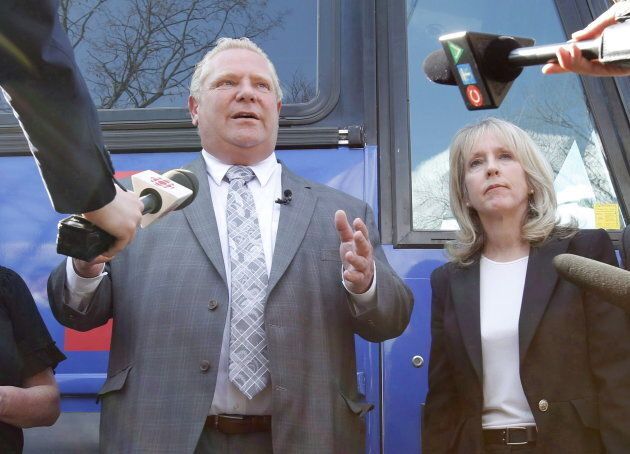
Toronto — Growing up in a low-income family, Tyler Riches knew from a young age he'd need to get creative if he wanted to go to university and graduate free from a mountain of debt.
Riches, now 18, was aware his parents didn't have the means to save up for his education, but the straight-A student and prime minister of his Hamilton, Ont. high school dreamed of attending the University of Toronto and building a career, perhaps in politics.
In February 2016, he was visiting Queen's Park on a school trip when Kathleen Wynne's Liberal government announced low-income Ontario students would be eligible for free tuition through the Ontario Student Loan Assistance Program. Riches felt elated.
"That was the first time I realized I will be able to pay for my education," Riches said.
With the help of the free tuition program, and other grants, Riches is in his second semester at U of T, aiming to major in political science, and double minor in women and gender studies and urban studies. He's also president of his residence house and is a representative in the student government.
His first year cost about $20,000 for tuition, a meal plan and residence. Now, with the province eliminating free tuition and making other changes to OSAP, Riches doesn't know how he'll tackle next year's fees without taking on considerable debt.
"I'm terrified because I just barely managed to pull through and get first year paid for," Riches said.

Minister of Training, Colleges and Universities Merrilee Fullerton announced Thursday that the province has instructed post-secondary institutions to reduce tuition by 10 per cent beginning next fall, and make some student fees optional, such as for clubs, publications and organizations. Student fees for walksafe programs, health and counselling, athletics and recreation and academic support will remain mandatory.
Students could save about $1,000 from having to pay fewer student fees, Fullerton said. Students attending universities will save about $660 in tuition, and those attending college $340, the province said in a statement. Graduate students will save in excess of $1,000.
In terms of OSAP, the province said it is adjusting the requirements so that more grants and loans go to students from low-income families.
More from HuffPost Canada:
"By making postsecondary education more affordable through historic reforms, refocusing supports to the families who need it most, and empowering students to choose how their fees are spent, we are restoring accountability, affordability and access to postsecondary education while giving more of our students opportunities to find a job and build a career right here in Ontario," Fullerton said.
The auditor general recently released a report that said with the changes the Liberal government had made, OSAP could cost the province $2 billion over the 2020 to 2021 school year, up 50 per cent from 2016 to 2017.
"The report supports the urgent need for financial sustainability, so future generations of Ontario's students can access financial support for postsecondary education," the province in a statement.
While it's true all students will save money from the tuition cut, not all students are better off, said Alex Usher, an expert in student financial aid and president of Higher Education Strategy Associates.
"Poorer students will lose more in student aid than gain from tuition cuts," Usher said. "The only students who are unambiguously better off come from quite rich families."
Watch: Students push for free education ahead of Ontario election. Story continues below
Student life will be impacted
Usher said he doesn't expect the tuition changes to significantly impact how many students attend colleges and universities, as they can still take out loans. The removal of student fees, however, will likely impact unions.
What the province is missing is that student unions are a fundamental part to campus life, enabling clubs, activities and student newspapers, Ushers said. "If they erase student unions, they erase skill development in university. That will hurt the quality of education."
Riches said while he's still figuring out how he will pay for tuition and living expenses next year, he's most concerned about the province making student fees optional.
"It's all that student leaders have been talking about. If student fees are optional, it means that large portions of student unions' and societies' operating budgets are eliminated. Gone. Kaput," Riches said.
Smaller universities will suffer
The province estimates post-secondary institutions will receive about $450 million less in tuition.
With large alumni bases, and significant international programs, U of T and other large universities will likely be able to make up the financial loss through "massive" fundraising efforts, and increasing tuition for international students, said English Prof. Holger Syme, a former department head. But he expects smaller universities that are not as well known internationally, like those in northern Ontario, will be hit hard.
"In most departments, there's very little money that's for discretionary spending. It's virtually all tied up in salaries and facilities essential to teaching, the cost of maintaining labs and hiring instructors," he said. The result will be fewer or larger classes, and fewer faculty, and more instructors hired on a causal basis.
"The things universities will be able to cut will lessen the educational experience and be bad for students," Syme said.
CORRECTION: A previous version of this story stated that the province estimates post-secondary institutions will receive about $450,000 less in tuition; the figure is actually $450 million.